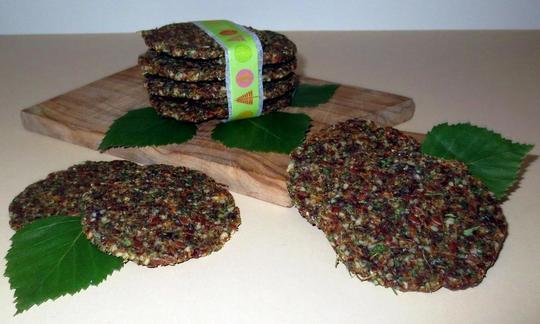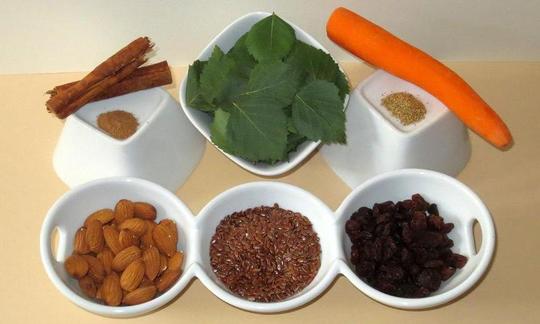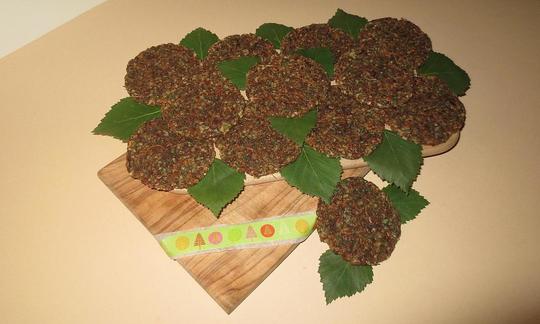Almond-birch bread (Birkentaler) with carrots and linseed
raw-vegan
Ingredients (for servings, )
Equipment
- blender or hand-held blender / immersion blender or shredder
- dehydrator or oven
- coffee grinder, electric
Type of preparation
- dehydrate
- chop or grind
- soak
- blend
- grate (shred)
- knead
Preparation
preparation the day before
Soak the almonds in water overnight. Then pour off the soaking water and rinse the almonds with water.Preparation about one hour before preparation
Cover the raisins with just enough water and let them soak for at least 30 minutes. Then pour off the soaking water.Preparation of almond birch bread with carrots
Remove birch blossoms from the inflorescence and/or prepare birch leaves.In this recipe, as you can see in the pictures, we used birch leaves. But you can just as easily use the flowers. Since they have a flour-like consistency, they ensure that the almond-birch biscuits hold together well.
Finely grate the carrots. Process the raisins together with the coriander seeds in an electric coffee grinder to form a creamy paste. Roughly chop the almonds and birch leaves and/or birch blossoms in a blender. Grind the linseed in an electric coffee grinder for about 10 seconds.
An electric coffee grinder is ideal for chopping the specified quantities of ingredients. A chopper in combination with a hand blender or a stand mixer are also suitable.
Mix all ingredients and knead well until a compact and malleable mass is formed.
Form 12 coins of about three to four millimeters height on baking paper.
If you want to use larger quantities: Roll out the mixture thinly between two sheets of baking paper and leave to dry for about an hour as described. Cut into desired portions and continue with the drying process.
An adjustable oven, food dryer or dehydrator is suitable for the drying process. Set the temperature to a maximum of 42 °C. After a drying time of at least 6 hours, you will have almond birch biscuits with a soft consistency.
For a storable, cracker-like result, you should allow a drying time of 12 to 24 hours.
If you do not want to use a raw food variant, you can use approx. 60 °C, which will also reduce the preparation time.
Allow the almond birch bread (Birkentaler) to cool or serve it warm straight away, with the birch leaves making a good garnish.
|
Nutritional Information per person
Convert per 100g
|
2000 kcal | |
|---|---|---|
| Energy | 122 kcal | 6.1% |
| Fat/Lipids | 7.9 g | 11.3% |
| Saturated Fats | 0.63 g | 3.2% |
| Carbohydrates (inc.dietary fiber) | 12 g | 4.3% |
| Sugars | 5.9 g | 6.5% |
| Fiber | 3.7 g | 14.8% |
| Protein/Albumin | 3.7 g | 7.4% |
| Cooking Salt (Na:8.8 mg) | 22 mg | 0.9% |
| Essential micronutrients with the highest proportions | per person | 2000 kcal | |
|---|---|---|---|
| Fat | Alpha-Linolenic acid; ALA; 18:3 omega-3 | 1.5 g | 76.0% |
| Min | Copper, Cu | 0.22 mg | 22.0% |
| Min | Manganese, Mn | 0.44 mg | 22.0% |
| Vit | Vitamin E, as a-TEs | 2.7 mg | 22.0% |
| Prot | Tryptophan (Trp, W) | 0.05 g | 19.0% |
| Fat | Linoleic acid; LA; 18:2 omega-6 | 1.6 g | 16.0% |
| Elem | Magnesium, Mg | 57 mg | 15.0% |
| Elem | Phosphorus, P | 103 mg | 15.0% |
| Prot | Threonine (Thr, T) | 0.13 g | 14.0% |
| Vit | Thiamine (vitamin B1) | 0.14 mg | 13.0% |
Detailed Nutritional Information per Person for this Recipe
The majority of the nutritional information comes from the USDA (US Department of Agriculture). This means that the information for natural products is often incomplete or only given within broader categories, whereas in most cases products made from these have more complete information displayed.
If we take flaxseed, for example, the important essential amino acid ALA (omega-3) is only included in an overarching category whereas for flaxseed oil ALA is listed specifically. In time, we will be able to change this, but it will require a lot of work. An “i” appears behind ingredients that have been adjusted and an explanation appears when you hover over this symbol.
For Erb Muesli, the original calculations resulted in 48 % of the daily requirement of ALA — but with the correction, we see that the muesli actually covers >100 % of the necessary recommendation for the omega-3 fatty acid ALA. Our goal is to eventually be able to compare the nutritional value of our recipes with those that are used in conventional western lifestyles.
| Essential fatty acids | per person | 2000 kcal |
|---|---|---|
| Alpha-Linolenic acid; ALA; 18:3 omega-3 | 1.5 g | 76.0% |
| Linoleic acid; LA; 18:2 omega-6 | 1.6 g | 16.0% |
| Essential amino acids | per person | 2000 kcal |
|---|---|---|
| Tryptophan (Trp, W) | 0.05 g | 19.0% |
| Threonine (Thr, T) | 0.13 g | 14.0% |
| Isoleucine (Ile, I) | 0.15 g | 12.0% |
| Phenylalanine (Phe, F) | 0.19 g | 12.0% |
| Valine (Val, V) | 0.17 g | 11.0% |
| Leucine (Leu, L) | 0.25 g | 10.0% |
| Lysine (Lys, K) | 0.13 g | 7.0% |
| Methionine (Met, M) | 0.04 g | 5.0% |
| Vitamins | per person | 2000 kcal |
|---|---|---|
| Vitamin E, as a-TEs | 2.7 mg | 22.0% |
| Thiamine (vitamin B1) | 0.14 mg | 13.0% |
| Riboflavin (vitamin B2) | 0.14 mg | 10.0% |
| Vitamin A, as RAE | 70 µg | 9.0% |
| Folate, as the active form of folic acid (née vitamin B9 and | 12 µg | 6.0% |
| Vitamin B6 (pyridoxine) | 0.07 mg | 5.0% |
| Niacin (née vitamin B3) | 0.72 mg | 4.0% |
| Biotin (ex vitamin B7, H) | 1.5 µg | 3.0% |
| Pantothenic acid (vitamin B5) | 0.14 mg | 2.0% |
| Vitamin K | 1.7 µg | 2.0% |
| Vitamin C (ascorbic acid) | 0.74 mg | 1.0% |
| Essential macroelements (macronutrients) | per person | 2000 kcal |
|---|---|---|
| Magnesium, Mg | 57 mg | 15.0% |
| Phosphorus, P | 103 mg | 15.0% |
| Potassium, K | 218 mg | 11.0% |
| Calcium, Ca | 52 mg | 7.0% |
| Sodium, Na | 8.8 mg | 1.0% |
| Essential trace elements (micronutrients) | per person | 2000 kcal |
|---|---|---|
| Copper, Cu | 0.22 mg | 22.0% |
| Manganese, Mn | 0.44 mg | 22.0% |
| Iron, Fe | 0.96 mg | 7.0% |
| Zinc, Zn | 0.64 mg | 6.0% |
| Selenium, Se | 2.2 µg | 4.0% |
| Fluorine, F | 20 µg | 1.0% |
| Iod, I (Jod, J) | 0.39 µg | < 0.1% |
Almond birch bread (Birkentaler) with carrots and raisins also contains a large portion of linseed and is therefore particularly rich in ALA, omega-3 fatty acid.
Flaxseed: Flaxseed is the seed of the flax plant, Linum usitatissimum. Flaxseed has a slightly nutty taste and a 40% fat content. With around 50% of the polyunsaturated omega-3 fatty acid alpha-linolenic acid (ALA), this has the highest concentration of omega-3 fatty acids of all known vegetable oils. Those who eat a lot of industrial food should generally increase their intake of flaxseed, because flaxseed has by far the highest content of essential omega-3 fatty acids and can correct nutritional errors in this regard.
Information about the birch:
- Where do birch trees grow? They can be found in open areas, in light deciduous and coniferous forests, on heathland and poor grassland.
- How do you recognize a birch? The deciduous tree is notable for its characteristic white bark. The foliage is light green and the triangular, dragon-shaped leaves are 4-7 cm long. The male flowers can be recognized by the catkins that form from April to May.
- Which parts of the birch tree can be used? In addition to extracting sap from the trunk, you can also harvest the catkins, leaf buds and young leaves. The edible inner bark should only be eaten when the tree is about to be felled, otherwise the tree could die.
Coriander seeds: Coriander ( Coriandrum sativum) belongs to the Apiaceae family. Both fresh coriander leaves and dried coriander seeds are used in cooking. Coriander seeds are spherical and have a bitter-spicy to sweet aroma. The ground seeds are used in the kitchen as spices. Coriander seeds taste particularly spicy if they are first roasted briefly and then ground or crushed in a mortar. Ground coriander does not keep for long due to the high proportion of essential oil.
Energetic birch blossoms: The pollen consists of valuable carbohydrates, proteins and fatty acids. Since they have a flour-like consistency, the blossoms are well suited to the cohesion and nutritional content of a raw bread.
Winter supplies: Dried leaves can be added to various doughs in winter, when there is hardly anything green to be found. They give patties, homemade bread mixes and crispbread a fine flavor.
Health effects of birch leaves: Birch leaves stimulate the metabolism, drain the body and can provide relief from rheumatic complaints. Internal and external use of infusions can also have a beneficial effect on skin diseases. The leaves contain up to 3% flavonoids, tannins, essential oils, bitter substances, vitamin C, resin and saponins.
Soak almonds: Soaking almonds overnight not only changes their consistency, but also reduces the phytic acid content. This forms solid complexes with certain food substances such as minerals and thus limits their absorption by the body.
Birch leaves and other uses: In addition to using birch blossoms as an ingredient in birch bread (Birkentaler), you can also use birch leaves. You can also add the leaves and blossoms to smoothies. The young, tender leaves are particularly tasty when used in salads. They are also recommended when chopped up in herb mixtures.
Raw food with an oven: If you do not have a suitable drying device such as a food dryer or dehydrator that allows good temperature regulation below 50 °C, this dish can also be prepared in raw food quality using an oven. To do this, simply set the lowest possible temperature (usually 50 °C) and leave the oven slightly open.
Taler variations with wild herbs: You can change this recipe as you like by using nettle leaves instead of birch leaves or birch blossoms. These have similar health benefits to birch. Garlic mustard is also recommended because of its peppery, garlic-like taste. Other suitable wild plants are meadow sage, wild mallow, meadow bedstraw, currant leaves or creeping bedstraw.








